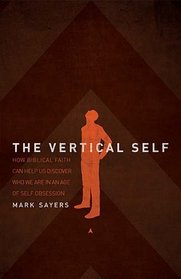Chris H. (trooperdog) reviewed The Vertical Self: How Biblical Faith Can Help Us Discover Who We Are in An Age of Self Obsession on
The Vertical Self by Mark Sayers has an interesting tagline: How Biblical faith can help us discover who we are in an age of self obsession. This is a topic that most Christian books dont address, so I figured this would be a good read.
The first half of this book is an interesting sociological look at how our Western culture views identity today. The authors premise is that in years past, people have had a vertical view of self, meaning, they viewed themselves based on a property understanding of who they are before God. But, Sayers says, todays culture tends to view people horizontally; we base our view of ourselves on how others see us and on how we fit in our society in terms of being cool and hip. Sayers critique of our culture is spot-on and he provides some interesting observations to prove this. My only critique of the first half of the book is that the author could have made his point in far fewer pages.
The second half of the book is where Sayers gives a spiritual recipe for realigning our viewpoint to having a vertical, rather than horizontal, self-perception. He has many good points in this section but I felt that calling for a renewed sense of holiness only partially addressed the issue at hand. Additionally, jamming the majority of his resolution into one rather long chapter made reading this section a bit difficult.
The Vertical Self provides fodder for some interesting discussions and I hope that the premise of the book will be discussed in greater circles.
The first half of this book is an interesting sociological look at how our Western culture views identity today. The authors premise is that in years past, people have had a vertical view of self, meaning, they viewed themselves based on a property understanding of who they are before God. But, Sayers says, todays culture tends to view people horizontally; we base our view of ourselves on how others see us and on how we fit in our society in terms of being cool and hip. Sayers critique of our culture is spot-on and he provides some interesting observations to prove this. My only critique of the first half of the book is that the author could have made his point in far fewer pages.
The second half of the book is where Sayers gives a spiritual recipe for realigning our viewpoint to having a vertical, rather than horizontal, self-perception. He has many good points in this section but I felt that calling for a renewed sense of holiness only partially addressed the issue at hand. Additionally, jamming the majority of his resolution into one rather long chapter made reading this section a bit difficult.
The Vertical Self provides fodder for some interesting discussions and I hope that the premise of the book will be discussed in greater circles.




